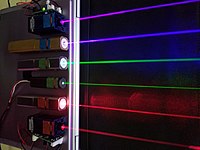
Photo from wikipedia
Nanosecond pulsed laser irradiation can trigger a release of nucleic acids from gold nanoparticles, but the involved nanoeffects are not fully understood yet. Here we investigate the release of coumarin… Click to show full abstract
Nanosecond pulsed laser irradiation can trigger a release of nucleic acids from gold nanoparticles, but the involved nanoeffects are not fully understood yet. Here we investigate the release of coumarin labeled siRNA from 15 to 30 nm gold particles after nanosecond pulsed laser irradiation. Temperatures in the particle and near the surface were calculated for the different radiant exposures. Upon irradiation with laser pulses of 4 nanosecond duration release started for both particle sizes at a calculated temperature increase of approximately 500 K. Maximum coumarin release was observed for 15 nm particles after irradiation with radiant exposure of 80 mJ cm-2 and with 32 mJ cm-2 for 30 nm particles. This corresponds to a temperature increase of 815 and 900 K, respectively. Our results show that the molecular release by nanosecond pulsed irradiation is based on a different mechanism compared to continuous or femtosecond irradiation. Local temperatures are considerably higher and it is expected that bubble formation plays a crucial role in release and damage to cellular structures.
Journal Title: Journal of biophotonics
Year Published: 2018
Link to full text (if available)
Share on Social Media: Sign Up to like & get
recommendations!